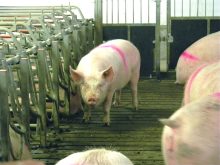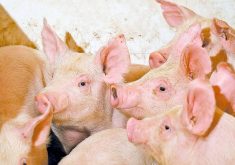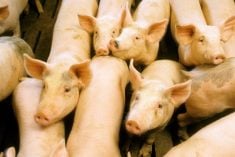Already beset by challenges due to low producer and processor margins, Ontario’s hog sector faces another test.
The news on May 11 that the United States Supreme Court had upheld California’s Proposition 12, which mandates that all pork sold in the state derives from sows housed to specified animal welfare requirements, adds another layer of strain.
Why it matters: Input costs have risen dramatically in the past year for Ontario’s hog producers. Lower prices paid by processors make it more difficult for them to recoup costs.
Read Also

Packer buys Green Giant, Le Sieur veg brands from U.S. owner
A Quebec-based processor’s deal to buy the Green Giant and Le Sieur packaged and frozen vegetable brands in Canada from a U.S. owner clarifies the status of two popular retail brands grown by Canadian farmers.
But the bigger concern, according to University of Guelph agri-business professor Ken McEwan, is the recent decimation of slaughtering capacity in North America. Some are temporary, in the form of labour disruption at a bacon-producing plant in Quebec, and some are potentially permanent, in the form of plant closures in Quebec and Minnesota.
There is a glimmer of short to mid-term hope from rising demand in Vietnam and Thailand, but that is tempered by unsettled trade relations between Canada and China. McEwan predicts “storm clouds on the horizon” before the trough in the hog sector’s well-established “good times, bad times” pattern levels off for producers.
McEwan said the potential for Prop 12’s trickle-down effects aren’t yet known.
“A lot of the meat California gets comes from the Midwest. In states like Iowa, I think there is concern. There will be effects.”
And it’s possible that, as processors look further afield for hogs that were raised to Prop 12’s specifications, the increased costs of segregating their supply chains may lower the prices paid for hogs that don’t meet the standards.
In the short term, McEwan said “the impact (of Prop 12) will be limited because not much pork meat from Ontario makes its way to California. For producers shipping to the U.S. (the pending enforcement of law beginning in July) could cause an issue because animals that don’t meet the space requirements will have to have their meat separated, which will drive up cost” on the processing and distribution sides.
Two Canadian processors, both of which either own or have control over a good portion of their supply, say they’re prepared for Prop 12. Maple Leaf Foods announced the conversion last year of its production facilities to loose sow housing. Quebec-based DuBreton requires adherence to standards by suppliers to its branded, humane-certified labels.
But even in those cases, the longer-term impacts of Prop 12 cause worry because of unknown costs and the unknown question of who will pay for inspection and enforcement on behalf of Californian authorities.
As McEwan notes, the May 11 ruling is on the backburner as Ontario’s pork sector assesses its situation and short-term future.
As reported by Don Norman in a recent edition of the Manitoba Co-operator, when Maple Leaf reported its first-quarter 2023 loss, it blamed “pork market headwinds” in addition to inflationary pressures for reducing the bottom line.
When demand for pork rose in 2021, the industry began producing more pigs. Now that prices have prompted consumers to either cut back on pork or opt for ground meat instead of tenderloin, there’s an oversupply.
“As prices go up, sometimes producers start to increase production, perhaps a little too early,” said Stephen Heckbert, executive director of the Canadian Pork Council. “Sometimes we outpace market demand with production. And that’s the cycle we’re in at this moment.”
According to McEwan, in most years Canadian hog producers can rely on some degree of “summer rally” due to barbecue season.
“Typically in Ontario, that comes around Pork Congress time,” he said, referring to the annual swine-sector showcase in Stratford, set to celebrate its 50th anniversary June 21-22. This year, that rally seems unlikely to happen.
“Hog producers in Ontario have gone through six months or longer of pretty challenging times and pretty significant losses on their margins due to high feed costs and lower hog prices, and I don’t see that changing much soon.”
McEwan said producers aren’t alone in feeling the strain. He cited low wholesale meat prices, rising labour costs, and inflationary pressure on transportation, packaging and marketing for driving down the margins earned on the processing side in Canada and the US.
American processors have historically had economies of scale on their side. But Canadian-owned HyLife’s recent announcement that it will close its slaughter plant in southwest Minnesota shows that hasn’t helped much in the current environment.
“For some time now, the company has been exploring several strategic options that would have enabled it to continue go-forward operations despite these financial challenges,” HyLife said in a memo to the Minnesota Department of Employment and Economic Development. “Unfortunately, so far, these efforts have not been successful.”
The plant had been processing 25,000 hogs per week and employed more than 1,000 people.
Paul Marchand, senior risk management analyst with H@ms Marketing, told the Manitoba Co-operator that the HyLife closure decision was based “purely (on) market conditions. … The plant was losing $6 million a month, according to their bankruptcy filings. This is all a function of the economic conditions that we’re in.”
At Vallée-Jonction Quebec, Olymel announced in April the closure of one of its slaughtering plants that was roughly similar to the Minnesota plant in employee numbers and slaughter capacity. Canadian Pork Council chair Rene Roy called it “tough news to hear, but we will work with governments and with our partners to find long-term solutions.”
“There are international markets for our products, and Canadian pork producers are
cost-competitive globally,” Roy said. “We need our trade agreements to work for us, we need our agricultural policies to work for us, and we need to work together as an industry to find long-term solutions.”
In late May, about 400 union members went on strike at Olymel’s bacon plant in Drummondville. As a result, McEwan reported, “the prices for bellies right now are particularly dampened.”
“These closures will increase the demand for slaughter space and likely cause more Ontario hogs to be shipped to the U.S.,” predicted McEwan, who said the Ontario sector ships 20,000 to 25,000 market hogs and 18,000 weaner pigs to the U.S. annually.
If that’s the case, recent developments in U.S. country-of-origin labelling represent yet another hurdle. U.S.-regulated products from animals born, raised and slaughtered in another country, but which are “minimally processed” in the U.S., can now be labelled as Product of U.S.A.
In early March, the United States Department of Agriculture proposed a rule that would tighten that definition, although compliance would be voluntary. The proposal was opened to public comment.
Canadian sector representatives registered their opposition, noting the highly integrated nature of the two countries’ pork supply chains.













